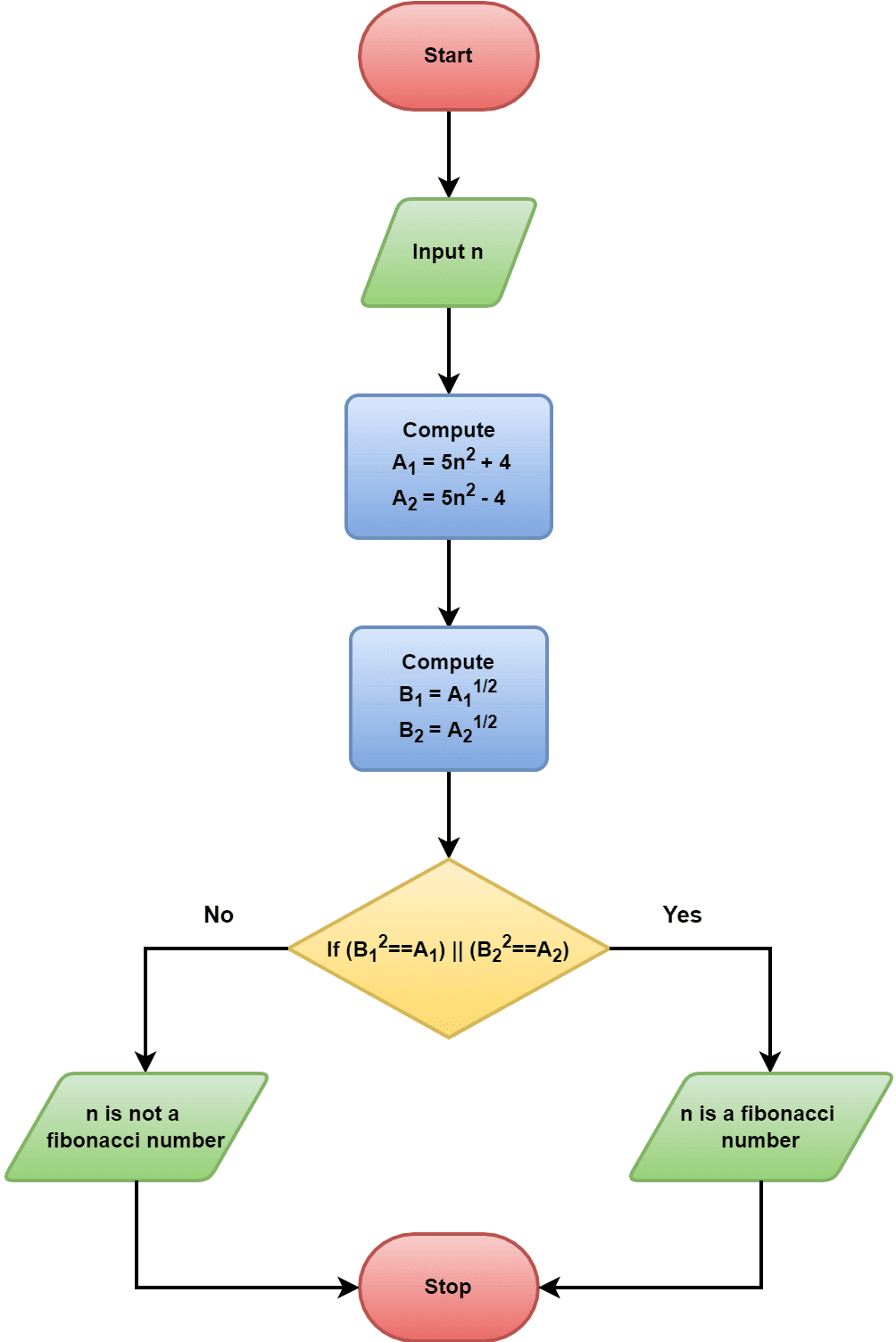1. 概述
在本教程中,我们将讨论斐波那契数列。我们会定义斐波那契数列,并探讨生成斐波那契数的不同方法。
最后,我们将提供一段伪代码,用于判断一个给定的数是否是斐波那契数。
2. 斐波那契数列简介
斐波那契数列是一组特殊的整数序列,形式如下:
0, 1, 1, 2, 3, 5, 8, 13, 21, 34, ...
斐波那契数列最初由印度数学家Pingala提出,后来由意大利数学家Leonardo Pisano Bogollo(又称Fibonacci)推广至西方世界。
该数列具有一个显著特性:后一个数等于前两个数之和。

例如:
- 34 = 21 + 13
- 8 = 5 + 3
- 下一个数应为 55 = 34 + 21
我们可以用以下递推公式生成斐波那契数列:
S₀ = 0
S₁ = 1
Sₓ = Sₓ₋₁ + Sₓ₋₂ (x ≥ 2)
其中,Sₓ 表示第 x 项。这样的定义帮助我们判断一个数是否是斐波那契数。
3. 用 Binet 公式计算斐波那契数
除了递推法,我们还可以使用黄金比例(Golden Ratio)来计算斐波那契数,这被称为 Binet 公式。
公式如下:
Sₓ = (φˣ - ψˣ) / (φ - ψ)
其中:
- φ(黄金比例)= (1 + √5) / 2 ≈ 1.618034
- ψ 是 φ 的共轭,等于 1 - φ ≈ -0.618034
将 φ 和 ψ 带入后,公式可简化为:
Sₓ = (1.618034ˣ - (-0.618034)ˣ) / √5
我们来验证几个数值:
| x | Sₓ(公式计算) | 实际值 |
|---|---|---|
| 5 | ≈ 5 | 5 |
| 6 | ≈ 8 | 8 |
| 7 | ≈ 13 | 13 |
结果吻合,说明 Binet 公式是有效的。
4. 判断一个数是否为斐波那契数的方法
我们可以通过以下步骤判断一个数 n 是否是斐波那契数:
✅ 判断逻辑:
计算两个值:
A₁ = 5n² + 4 A₂ = 5n² - 4判断 A₁ 或 A₂ 是否是完全平方数(perfect square)
⚠️ 什么是完全平方数?
一个数 p 是完全平方数,当且仅当存在整数 q,使得:
q² = p
如果 A₁ 或 A₂ 是完全平方数,则 n 是斐波那契数。
流程图如下:

5. 伪代码实现
以下是判断一个数是否是斐波那契数的伪代码:
algorithm CheckIfFibonacci(n):
// INPUT
// n = the input number
// OUTPUT
// "Yes", if n is a Fibonacci number
// "No", if n is not a Fibonacci number
A1 <- 5 * n^2 + 4
A2 <- 5 * n^2 - 4
B1 <- sqrt(A1)
B2 <- sqrt(A2)
if (B1^2 = A1) or (B2^2 = A2):
return "Yes"
else:
return "No"
时间复杂度分析:
- 单个数字判断:O(1)
- 若判断 N 个数字:O(N)
6. 伪代码验证
我们用几个例子验证伪代码:
示例 1:n = 5
- A₁ = 5×5² + 4 = 129 → √129 ≈ 11.36 → ❌
- A₂ = 5×5² - 4 = 121 → √121 = 11 → ✅
结论:5 是斐波那契数 ✅
示例 2:n = 7
- A₁ = 5×7² + 4 = 249 → √249 ≈ 15.78 → ❌
- A₂ = 5×7² - 4 = 241 → √241 ≈ 15.52 → ❌
结论:7 不是斐波那契数 ❌
7. 应用场景
斐波那契数列在多个领域有广泛应用:
✅ 计算机科学:
- 音频压缩(lossy compression)
- 二叉树结构
- 斐波那契堆(Fibonacci Heap)
- 排序算法优化
- 黄金分割搜索
- 伪随机数生成器
✅ 数学领域:
- 优化方法
- 最大公约数计算
- 数学游戏预测
- 动态整数生成
✅ 其他领域:
- 高能物理
- 量子力学
- 密码学
8. 总结
本教程我们讨论了:
- 斐波那契数列的定义与生成方法
- 使用 Binet 公式计算斐波那契数
- 判断一个数是否为斐波那契数的算法与伪代码
- 通过实际例子验证了判断逻辑的正确性
掌握了这些内容,你可以快速判断一个数是否属于斐波那契序列,并在实际项目中加以应用。